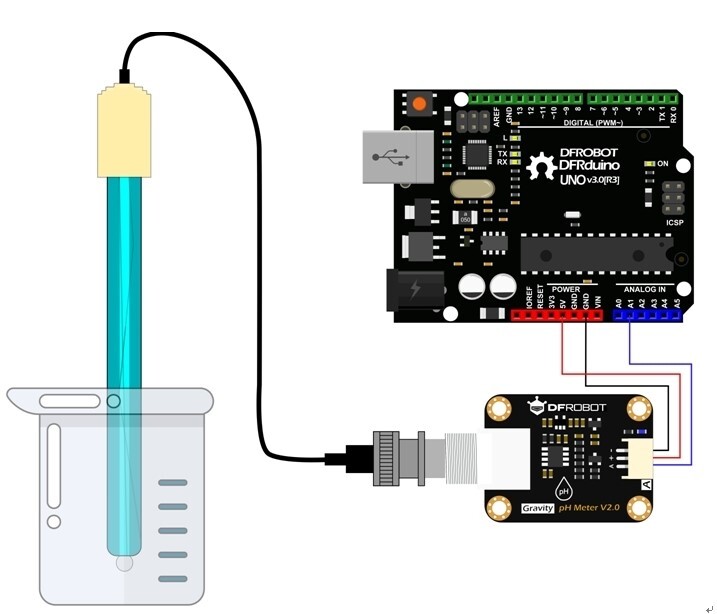Product Overview
IMPORTANT: Due to import restrictions, we have modified the original liquid solutions with powdered solutions. You can use distilled or deionized water to dissolve the packets.
Analog pH meter V2 is specifically designed to measure the pH of the solution and reflect the acidity or alkalinity. The pH sensor is commonly used in various applications such as aquaponics, aquaculture, and environmental water testing. The onboard voltage regulator chip supports a wide voltage supply from 3.3v to 5.5v, which is compatible with the 5V and 3.3V main control boards. The output signal filtered by hardware has low jitter. The software library adopts the two-point calibration method, and can automatically identify two standard buffer solutions (4.0 and 7.0), so simple and convenient.
The sensor can be easily connected to most popular microcontrollers (such as Arduino), with its Arduino library, you can quickly build a pH meter, plug and play. The pH is a scale of hydrogen ion activity in the solution. The pH has a wide range of uses in medicine, chemistry, and agriculture. Usually, the pH is a number between 0 to 14. Under the thermodynamic standard conditions, pH=7, which means the solution is neutral; pH<7, which means the solution is acidic; pH>7, which means the solution is alkaline.
Specification
- Supply Voltage: 3.3~5.5V
- Output Voltage: 0~3.0V
- Probe Connector: BNC
- Signal Connector: PH2.0-3P
- Measurement Accuracy: ±0.1@25℃
- Dimension: 42mm*32mm/1.66*1.26in
- Probe Type: Laboratory Grade
- Detection Range: 0~14
- Temperature Range: 5~60°C
- Zero Point: 7±0.5
- Response Time: <2min
- Internal Resistance: <250MΩ
- Probe Life: >0.5 years (depending on the frequency of use)
- Cable Length: 100cm

Attention
- The BNC connector and the signal conversion board must be kept dry and clean, otherwise, it will affect the input impedance, resulting in an inaccurate measurement. If it is damp, it needs to be dried.
- The signal conversion board cannot be directly placed on a wet or semiconductor surface, otherwise, it will affect the input impedance, resulting in an inaccurate measurement. It is recommended to use the nylon pillar to fix the signal conversion board, and allow a certain distance between the signal conversion board and the surface.
- The sensitive glass bubble in the head of the pH probe should avoid touching the hard material. Any damage or scratches will cause the electrode to fail.
- After completing the measurement, disconnect the pH probe from the signal conversion board. The ph analog sensor probe should not be connected to the signal conversion board without the power supply for a long time.
- The bottle cap of the probe contains protective liquid (3.3mol/L KCL). Even if the bottle cap is screwed tightly, some protective liquid may still leak around the bottle cap, forming white crystals. But as long as there is still protective liquid in the bottle cap, it will not affect the life and accuracy of the probe. So please use it with confidence. It is recommended that the white crystals be poured back into the protective liquid in the bottle cap.
Features
- Compatible with Arduino/Raspberry Pi(with and Analog to digital converter ADC) and any microcontroller with Analog input interface.
- 3.3~5.5V wide voltage input
- Hardware filtered output signal, low jitter
- Gravity connector and BNC connector, plug and play, no welding
- The software library supports two-point calibration and automatically identifies standard buffer solution
- Uniform size and connector, convenient for the design of mechanical structure
Warning
- Analog pH Sensor/Meter Kit V2 are intended for testing in laboratory environments only. The probes are subject to data drift after extended measurements.
Package include
- pH Probe(Laboratory Grade) x1
- pH Signal Conversion Board x1
- Analog Sensor Cable x1
- pH Standard Buffer Solution 4.0 x1
- pH Standard Buffer Solution 6.86 x1
- pH Standard Buffer Solution 9.18 x1
- Plastic solution containers x3
- Distilled/deionized water not included
- Waterproof Gasket x2
- Screw Cap for BNC Connector x1
- M3 * 10 nylon pillar x4
- M3 * 5 screws x8
Instrucciones para las soluciones en polvo
-
Usa agua destilada o desionizada de buena calidad (preferiblemente con conductividad <1 µS/cm).
-
Sigue exactamente la cantidad indicada en el sobre del buffer. Por ejemplo, si dice disolver en 250 ml, usa exactamente esa cantidad.
-
No usar recipientes metálicos para disolverlos, porque podrían reaccionar y alterar el pH.
-
Guarda la solución en un frasco limpio y bien cerrado, a ser posible de plástico o vidrio, y etiquétalo con la fecha de preparación.
- Si deseas hacerlo de forma proporcional puedes utilizar 0.2 gramos por cada 50 ml de agua destilada
Introductory Videos of usage
Project 1. Manual calibration of an Analog pH Sensor (with Linear Algebra)
- This video is an overview and tutorial for an analog pH sensor that's compatible with both Arduino and Raspberry Pi. It will also give a general overview of linear functions and interpolation. Plus it will show you how to write a custom code to use this sensor on an unsupported platform (Espruino).
Project 2. pH Sensor: Assembling, Coding, & Calibrating with Arduino | Smart Gardening
- Introduction: This video talks about what pH sensors are, why use them for aquaponics system, and how to assemble, code, and calibrate the Gravity: Analog pH Sensor (Version 2).










